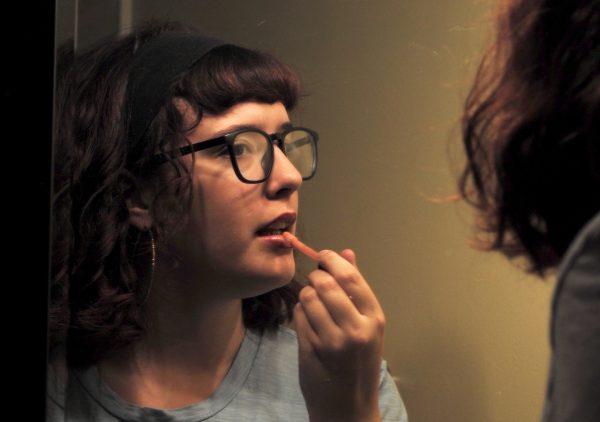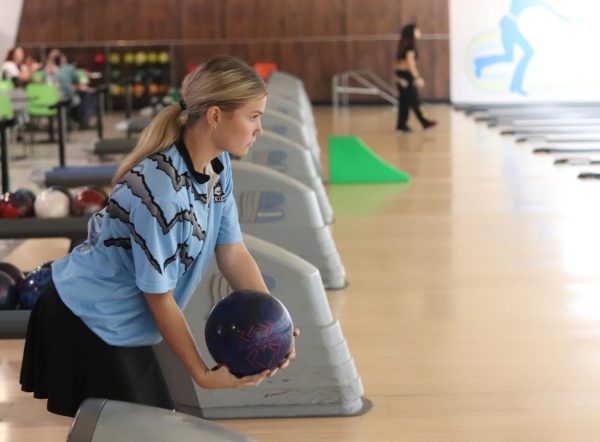The pros of pronouns
How the GSA’s speech on preferred names and pronouns shifted campus life for LGBTQ+ students
photo by Rhea Rose
GSA treasurer Lexi Cunningham and president Michaela Maschhoff talk with other board members at the club’s first staff meeting. The GSA leadership met on Aug 23 to discuss board rules, campus safety, and upcoming plans for the year.
Last year, after being online for half of the semester, John* (he/him), a transgender student, walked into his first in-person class. He, like many freshmen, looked forward to new friends, engaging classes, and special memories. Also like other freshmen, John expected to be addressed by his preferred name and pronouns, but instead, he was met with his teacher using his deadname, Jane*, as he walked through the door.
“I always email my teachers before the school year starts so they know in advance, though it still makes me nervous to start school because I’m unsure if they will slip up in class,” John said. “I just feel safer without strangers knowing.”
“He/him,” “she/her” and “they/them.” Pronouns are used frequently in daily conversations when referring to objects and people, yet many don’t even think about which ones to use. While many people use pronouns based on their sex assigned at birth, others use different pronouns to help express themselves and their gender identity. Although using historically plural pronouns like “they/them” when referring to a singular person can be confusing for some, preferred pronouns and names must be used inside the classroom to make students feel more comfortable and safe in their learning environment, according to the Gay-Straight Alliance club.
On Aug. 9, GSA gave a speech to teachers and administration on the importance of using students’ preferred names and pronouns in the classroom setting.
“One of our main topics that we addressed was using proper pronouns in the classroom and how that can help someone,” GSA president Michaela Maschhoff (they/them) said. “We also talked about how not using these pronouns can affect someone mentally and how detrimental it can be to someone if their identity is being essentially ignored.”
The speech given by Maschhoff and former GSA secretary Marlie Tollefson (she/they), was made in collaboration with principal Robert Frasca (he/him), who asked them to speak to the faculty.
“I’ve been working with the leadership of our GSA for probably about six, seven months now. I’ve met with them as a group and they’ve done some trainings through their organization,” Frasca said. “I’ve been really concerned with diversity and inclusion on our campus, GSA being a part of that, but even bigger, culturally, racially, just making sure all of our kids feel safe on campus.”
Maschhoff and Tollefson worked over the summer to prepare their speech by talking with activist Ashley Rhodes-Courter, an advocate for foster-care and LGBTQ+ children in Florida. The GSA leadership also included research and statistics on how feeling safe in the classroom can affect students both academically and in their relationships with their teachers and peers.
“I made sure to mostly address different pronouns, how to correctly use pronouns, how using people’s names can make the classroom more safe, and how teachers can identify to students that their classroom is a safe place,” Tollefson said.
In part with addressing ways to make students more comfortable in their classrooms, the GSA and Frasca worked to create surveys for teachers to use during the first week of school. These surveys included questions for students relating to their pronouns, preferred names, and with whom their teachers can use certain names and pronouns.
“We did give out some of the surveys, but a lot of the teachers actually made them on their own. We kind of told them what to put on there and how they should address it in their classrooms, and it was great seeing that in some of my classrooms as well,” Maschhoff said.
While most teachers handed out questionnaires, made Google surveys, or even put their own pronouns on their whiteboards, not all teachers participated in this attempt to increase inclusivity on campus.
“I think that it has reached a lot of the staff, but unfortunately, I have seen some staff that have not been listening to what we said and not following what we encouraged them to do,” Maschhoff said. “But still, a lot of teachers learned from that experience and from what we have told them.”
However, for the teachers that did give out surveys and had conversations relating to inclusion, many of their LGBTQ+ students were grateful for their support and the efforts made to make them feel safe in their classroom.
“With the teachers that had handed those out, I definitely feel safer in their classrooms because it lets me know that they understand my identity, at least to some extent, and that they respect it,” GSA vice president Angelique Boles (she/they) said. “It makes me feel a lot more comfortable in their classrooms.”
Teachers welcoming LGBTQ+ students into the new school year allowed them to feel both accepted and safe, creating contrast from previous school year experiences.
“In the past, I wasn’t sure which teachers were safer to interact with because I didn’t know if they would share information about me with other teachers and students,” John said, “But now with the surveys, I feel like you can tell which teachers are more supportive than the others.”
LGBTQ+ students, GSA leadership and administration look forward to the progress being made this school year. Teachers continue to learn more on how to respect their students’ identities through the use of pronouns and names, but mere respect is just the beginning.
“I think that there’s always more that can be done, but so far this is a really good step in the right direction,” Boles said. “I just think that these conversations need to be brought up more where it’s applicable. Like obviously, math teachers don’t have a lot of space to talk about it, but maybe history teachers can implement a few historically LGBTQ+ people in there… or English teachers implement more LGBTQ+ literature to just show it more in the classroom.”
Through surveys, google documents, and a ten-minute speech, the GSA has helped to encourage both inclusivity and respect on campus, helping teachers, administrators, and students improve the academic and social life at school.
“We’ve talked a lot with our staff about the fact that all students will learn, that’s our goal,” said Frasca, “That’s why we’re here as a school, for all of our students to learn, but I know that all students can’t learn until all students feel safe.”
*names changed for privacy
Your donation will support the student journalists of Hagerty High School. We are an ad-free publication, and your contribution helps us publish six issues of the BluePrint and cover our annual website hosting costs. Thank you so much!













